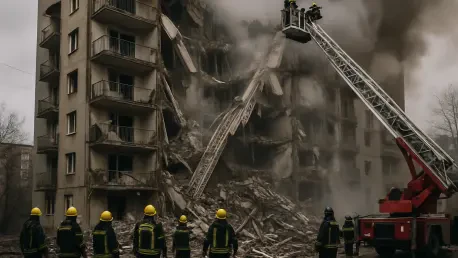The building safety crisis in Wales has ignited a firestorm of frustration among leaseholders, who find themselves trapped in high-rise flats plagued by fire hazards, with little progress toward resolution despite ongoing efforts. These individuals, owning flats under lease agreements, are increasingly vocal about the Welsh Government’s building safety pact—a voluntary agreement with major developers aimed at remediating safety issues in buildings over 11 meters tall. Despite its promise to address critical fire risks, the pact has been met with sharp criticism for its glaring inefficiencies. Leaseholders are left in limbo, grappling with properties they cannot sell and facing mounting emotional and financial burdens, while the pace of repairs remains alarmingly slow. This growing unrest paints a stark picture of a system failing to protect some of its most vulnerable residents, raising urgent questions about accountability and the need for stronger measures to ensure safety.
Frustrations with the Building Safety Pact
Leaseholder Discontent and Policy Shortcomings
The core of leaseholder frustration lies in the perceived inadequacy of the Welsh Government’s building safety pact, which many argue lacks the power to compel developers to act swiftly. Residents such as Marc Harries of Victoria Wharf and Mark Thomas of Celestia in Cardiff have openly criticized the agreement as “completely unfit for purpose,” pointing to the absence of strict timelines and enforceable consequences for non-compliance. This voluntary framework, meant to ensure remediation of fire safety defects, has failed to deliver tangible results for many. With only 43% of the 461 identified high-rise buildings showing completed or ongoing work as of recent data, the slow progress has deepened distrust. Leaseholders fear that without mandatory deadlines, the process could drag on for years, leaving them stuck in unsafe living conditions with no clear end in sight. The sentiment is one of betrayal, as the pact’s “light-touch” approach seems to prioritize developer leniency over resident safety.
Beyond individual grievances, the broader statistics underscore the scale of the problem and amplify calls for reform. Of the 161 private sector buildings identified for remediation, a mere four have been fully addressed, highlighting a systemic failure to tackle the crisis at a meaningful pace. This sluggish advancement fuels concerns that full remediation might not occur until well into the next decade, potentially beyond 2030. Leaseholders are not just frustrated but also alarmed by the lack of urgency from both government and developers. Many argue that the voluntary nature of the pact allows developers to delay action without fear of repercussions, placing the burden of uncertainty squarely on residents. The Welsh Government’s commitment to regular engagement with developers has been noted, yet for those living in affected flats, such assurances ring hollow when progress remains minimal and their daily lives are disrupted by ongoing safety fears.
Emotional and Financial Impact
The personal toll of this crisis on leaseholders cannot be overstated, as many endure profound emotional and financial strain while waiting for solutions. Residents like Rob Nicholls of Altamar in Swansea speak of sleepless nights, haunted by the fear of living in unsafe conditions and the inability to sell properties now deemed “worth nothing” on the market. The financial repercussions are equally devastating, with individuals struggling to secure mortgage extensions or manage escalating costs tied to legal negotiations. This constant state of limbo erodes mental well-being, creating a pervasive sense of helplessness among those affected. The contrast between their hardship and the apparent indifference of developers and agents only deepens the frustration, as leaseholders feel abandoned by a system that should prioritize their safety over corporate convenience.
Adding to the distress is the stark power imbalance leaseholders face when dealing with developers over remediation agreements. Lacking legal expertise, many residents are forced to navigate complex contracts on their own, a process that often stretches over months and delays on-site work. A striking example comes from Celestia in Cardiff, where negotiations with Barratt Redrow stalled due to last-minute clause additions, leaving leaseholders feeling outmatched and powerless. This dynamic not only slows progress but also exacerbates the financial burden, as legal fees pile up with no guarantee of resolution. The absence of protective mechanisms to level the playing field leaves residents vulnerable, intensifying their call for government intervention to shift the responsibility away from individuals and onto those who built the defective structures. The ongoing struggle reveals a deeper flaw in the current framework, where leaseholders bear the brunt of systemic inaction.
Calls for Stronger Intervention
Demand for Legislative Reform
Amid the mounting frustration, a unified chorus of voices—from leaseholders to campaign groups—demands legislative reform to address the shortcomings of the current safety pact. Organizations like the Welsh Cladiators, represented by advocates such as Peter Larwood, argue that voluntary agreements are insufficient to compel developer action. They push for laws with real consequences, including financial penalties targeting profits, to ensure compliance and protect residents from bearing remediation costs. This call for stricter measures reflects a broader belief that only enforceable mandates can break the cycle of delays that have plagued high-rise safety efforts. The fear of prolonged uncertainty, with some estimating delays stretching beyond the next five years, underscores the urgency of embedding accountability into the system rather than relying on goodwill from corporations.
Local authorities have also joined the push for a tougher stance, amplifying the pressure on the Welsh Government to act decisively. Cardiff’s council, for instance, has urged a firmer approach with private developers, emphasizing the need to expedite remediation and alleviate the burden on leaseholders. This alignment between local governance and resident advocacy highlights a growing consensus that systemic change is essential. The current framework, lacking deadlines and punitive measures, is seen as a barrier to progress, leaving thousands in unsafe conditions with no clear timeline for resolution. The collective demand for legislation that prioritizes resident safety over developer convenience signals a critical turning point in the debate, as stakeholders seek to reshape policy to address the human cost of inaction. The momentum for reform continues to build, driven by the shared recognition that half-measures are no longer acceptable.
Developer Responses and Disconnect
Developer responses to the crisis often cite logistical and legal complexities as reasons for the slow pace of remediation, yet these explanations do little to ease leaseholder concerns. Companies like Bellway, responsible for buildings such as Altamar, have acknowledged the challenges of coordinating repairs and navigating procedural hurdles, but their statements fall short of offering concrete timelines or solutions. This justification, while perhaps valid from a corporate perspective, appears detached from the immediate realities faced by residents living in affected flats. The gap between developer reasoning and leaseholder experience widens the rift of trust, as many residents perceive a lack of urgency or accountability in these responses. The ongoing delays, regardless of stated reasons, continue to leave flats unsafe and unsellable, perpetuating a cycle of frustration for those most impacted.
This disconnect underscores a fundamental flaw in the current approach to building safety in Wales, highlighting the urgent need for a more robust framework. While the Welsh Government asserts its dedication to resolving the issue through developer engagement and potential enforcement actions, tangible results remain scarce for many. Leaseholders and advocates argue that without binding mechanisms to hold developers accountable, such as penalties or mandated deadlines, the justifications for delays will persist unchecked. The lived experiences of residents—marked by financial ruin and emotional distress—stand in stark contrast to corporate narratives, emphasizing that systemic reform must bridge this divide. Looking back, the struggle reveals a critical lesson: voluntary pacts alone cannot address the depth of the crisis. Moving forward, the focus must shift to implementing enforceable policies that prioritize resident well-being, ensuring that future safety efforts are grounded in accountability and swift action to prevent such prolonged hardship.









